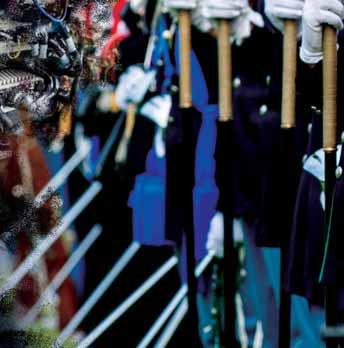Esh Vsi























The “Rivista Militare” is a training ground for thought aimed at disseminating and informing on what concerns military culture and all the issues and aspects which may refer to it. The “Rivista” focuses on the Army through debate and free and direct participation.


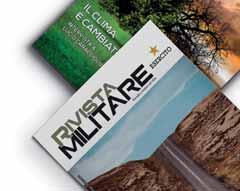

“The ground that science does not gain is inexorably conquered by ignorance”. (L. Mezzacapo)
The ideas expressed in the articles are personal to the authors and have following current privacy protection regulations. The publisher declares he is ready to regularise any copyright due to the reproduced images of




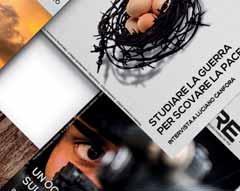
Translations by the interpreters’team, Protocol and External Relations Branch, IT-Army General Staff.
 28° reggimento “Pavia”
Pesaro (PU)
28° reggimento “Pavia”
Pesaro (PU)
Dear readers,
I am pleased to inform you that Rivista Militare –a periodical which the brothers Luigi and Carlo Mezzacapo founded back in 1856 – is once again available in English. This issue comprises a selection of the best articles published in 2022. It is, therefore, a special edition with an international vocation. The aim is to strengthen relations with all the other publishers in the sector (particularly EMPA, the European Military Press Association) and provide a valuable information tool for multinational circles. The selected articles range from climate change to the condition of women in the military context and much more.










In the hope of having done something pleasant, I wish you a good reading.










 by Grammenos Mastrojeni Grammenos
by Grammenos Mastrojeni Grammenos
The IPCC (Intergovernmental Panel on Climate Change) counts even more of them in various Reports. They are due to direct impacts of the climate or mediated by other forms biodiversity.

multifactorial; among them, ecosystem services’ disappearance, displacement or uncertainty is dominant. Climate is the synchroniser of natural cycles, and its relative stability and predictability affect the stability and predictability
of other ecosystem cycles, such as
can no longer count on the presence of certain further regular phenomena in the ecosystem at the desired time and place. Many of these phenomena appear above all as “services” nature does to itself, to its balance. For example, the warmth induces plants to blossom and sets in motion a series of events of vital importance for the animal kingdom, such as the availability of fruit in the period of wildlife births. By making these regularities uncertain, a changing climate puts the entire natural world in distress and causes the dramatic loss of biodiversity we are witnessing. However, many of these
regular phenomena are also services on which humanity directly relies: these



and their disappearance, dislocation or unpredictability makes it impossible to organise many human activities. In other words, you cannot plan the harvest without being able to count on certain rains or temperatures, but neither can you design a road without knowing whether a particular valley will

Such uncertainty makes society
unstable. Climate change creates instability in two different ways. First, the climate of a more energetic atmosphere produces more violent phenomena that






violent precipitation of increasing intensity. Secondly, the cyclical arrival of certain natural services on which we rely to orderly organise society and production becomes unpredictable. These services are largely climate dependent and cover a broad spectrum, far beyond agricultural performance. Among them are health services, such as the rigours of winter preventing certain parasites from
in wetlands and encompass local climate mitigation, such as vegetation
regulating temperatures. They comprise infrastructure services, such as the ability of certain plants to hold
a slope overhanging a highway, up to reaching much more imponderable but equally essential services, which can even be of social balance or cultural identity. One would think they are secondary aspects, yet the
confers or removes a productive role to women in some rural contexts. An unpredictable and unprecedented extreme climate turns into a problem for economic security and human rights: it suppresses, dislocates, or randomises ecosystem services; that
is, it makes them unpredictable. It causes insecurity while opening up the competition to grab the dislocated and more scarce services. Competition peaceful in more prosperous and structured contexts. In the more fragile countries, on the other hand, it more easily triggers formalised or creeping
Thus, the environmental collapse we are causing will not remain a tragedy that we could allow ourselves to observe with detachment from our tower raised above all and perhaps with saddened compassion for the sufferings of Gaia, the Earth. Suppose











we do not stop it in time. In that case, the collapse will overwhelm us, too: the environmental imbalance turns into a human imbalance, and the collapse of ecosystems will become the collapse of societies. Because we are part of that same nature that we are killing, on

to grab the leftovers, risking perishing along with her.
We have entered the ecosystem “collapse threshold”. Whether the collapse actually takes place depends on our ability to defuse a scenario of inert continuity of our behaviour. That is to say that if, for the next few years, the human pressure on nature follows its usual trends, continuing to increase as if nothing were, the scenario that we would face would be very problematic in itself and is stigmatised as “business as usual”. It envisages the humanity that continues undaunted to do what it has always done, an actor who is not reactive to the growing changes in the ecosystem. Nevertheless, it is a tragically optimistic scenario. If, instead of contemplating in future the humanity that at worst does not change course, we insert probable human reactions to environmental degradation into the
equation, the picture worsens terribly. The worst scenario described by the IPCC is that of a temperature increase of 4.8 degrees within a century. This would mean a real mass extinction on land and seas, rapid and traumatic rises in ocean levels, which will engulf many inhabited coastal areas, disastrous alternation of droughts

and much more. The biosphere mechanisms that likely make such an impressive acceleration of warming are called “positive feedback loops”, i.e., incremental dynamics inherent in the biophysical system, which are set in motion if certain heating levels are exceeded. According to scientists, this would happen if the 2 degrees threshold was exceeded, which should be absolutely avoided. Some of these
most worrying of them is the thawing of permafrost, releasing methane, a much more powerful greenhouse gas than carbon dioxide. Terrestrial mechanisms of this type are less drastic, although not very different than those which have condemned the Venus planet to average temperatures above 450




degrees. These high temperatures are due to the fact that beyond a certain temperature threshold, Venus’ surface
the same minerals, in an incremental loop with a hellish outcome. However, another incremental loop, of which we
The IPCC believes that the fearful biophysical scenario of feedback loops is achievable in the case of the human as “business as usual”. Basically, it depends on human behaviour, and there are many chances of creating catastrophe if we humans continue “business as usual”, i.e. to act as always, as if the problem did not exist. But that is not all. While aware of this,
In reality, if we exceed 2 degrees Celsius, the scenario of humankind continuing undeterred to do what it has
entirely optimistic hypothesis. On the contrary, an unpropitious incremental loop of irresponsible conduct risks
setting in motion a destructive dynamic in the human sphere in parallel with the growing disaster in the biosphere, with the two dynamics triggering each other. In fact, severe climate changes will lead to rapid displacements of available resources, including the most basic ones, such as water, arable and habitable land, and food. We will then witness competitions and hoards, pockets of instability, violent poverty, and migratory waves of unprecedented the only human response possible to cooperative, and concerted response implement; and Mars, the god of war, would inevitably appear on the scene.
against the backdrop of weird weather; humankind bombards itself instead of committing to reduce emissions, and mors tua becomes vita mea. Although this scenario does not yet have a it must absolutely be avoided and that we must act immediately. All this could happen quickly, and we have very little room for manoeuvre before Venus and Mars awaken: this is at stake.
ches Environment and Geostrategy



nal universities and has dedicated himself, for over thirty years, to the issue of climate change on the planet. Former coordinator for the





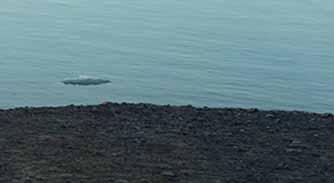



deputy assistant secretary of the Union for the Mediterranean, based in Barcelona. He participates in major international negotiations on climate, biodiversity, water and oceans. Author of several successful articles and monographs, among others, he has published L’arca di Noè (2014), Effetto
 Photo: corporate enel it Photo: corporate.enel.it
la Terra; e cosa può farci ognuno di noi (2016) for Amazon.
Fig. 1
Photo: corporate enel it Photo: corporate.enel.it
la Terra; e cosa può farci ognuno di noi (2016) for Amazon.
Fig. 1



 by Anna Maria Isastia Anna Maria Isastia
by Anna Maria Isastia Anna Maria Isastia
During the First World War, in addition to assisting and caring, women could replace men in all their activities, even in those hitherto precluded, occupying Women had never worked in arms factories in Italy, but what was also called the ‘industrial war’needed staff. Men could not cover the vast demand for producing fuses, detonators, and bullets. Thus, women were hired in the ammunition departments, and the propaganda did the rest in the newspapers, publishing photos of hundreds of women at work.

they were ordered to employ female labour also in heavier jobs because it



was indispensable to the new industrial system, which, due to war requirements, had to work at full capacity. Thus, the number of women hired in auxiliary establishments increased. At the end of the war, more than 200,000 women were employed in the war industry, while at least 600,000 were manufacturing military clothing. It is just one of the many upheavals imposed by the war on Italian society, which until that moment had persisted in considering women as fragile, weak, incapable of any autonomy, and completely subordinate to fathers or husbands. The laws were clear. If the woman were minor, her father would
decide for her, while as a married woman, any activity or initiative not authorised by her husband was forbidden. The First World War forced everyone to review this functional reality aimed only at preserving the authority of the pater familias. The men left for the front, and the war continued beyond all reasonable expectations: not for months but years. It was impossible to force hundreds of thousands of women to have a spouse hundreds of kilometres away to sign their authorisation to buy, sell, rent, trade, or carry out any business. Therefore, it was necessary to suspend the marital authorisation derogating the civil code provisions. During the war, a series of interim measures were taken to make
women autonomous and put them in a position to contribute to the national economy.
driver (3200 women) and postwoman, indispensable even if insulted and mocked. In the countryside, men were generally replaced by women and boys since almost all the peasants had been recalled. The peasant women, therefore, had to resign themselves to taking on their shoulders, with enormous effort, the work of men, guaranteeing food, not only to their families but also to the cities and soldiers. Women had always worked in the countryside picking grapes and olives or threshing wheat, but during
the war, they had to dig, plough, and of the sexual division of labour. In the fell very slightly, despite the absence of male labour, the scarcity of fertilisers, requisitions carried out in large numbers. The skills of the female landowners and tenants who replaced their husbands in running the family businesses contributed to the positive results. Nobles and bourgeois throughout Italy created an increasingly dense network of committees and associations, which carried out the most diverse but indispensable tasks. Let us remember that at the beginning of the twentieth
century, there was nothing that could be assimilated into modern public social assistance. The war preparation and followed by the assistance committees many civil organisation committees mainly entrusted to women: assistance to children, widows, orphans, mothers of the fallen, the children of soldiers, prisoners of war, and all the vulnerable layers of the population the war had reduced to misery. Propaganda and assistance were the two pillars of women’s activism in the long years of war.

woman, Countess Lina Bianconcini Cavazza, had the idea of setting up










had the task of integrating the activities of the Information Service of the Military Intendencies. The association’s role was to collect news of dead, wounded and missing soldiers to give answers to families. 25,000 female volunteers activated 8400 sections. The military’s distrust and complex relations forced to pass a decree that required the military commands and chaplains to provide all the requested information
granting allowances and pensions. At the military combatants had been collected and processed at the headquarters in according to the research results to facilitate replies to family members. Hundreds of thousands of women factories, holding all kinds of positions where it was essential to replace men at the front. Thousands of them entered banks. Hundreds of women created the the weakest. Alongside all of them, we should remember a few dozen women whose presence seemed so unusual that they were quickly erased from memory.

It took Elena Branca’s stubborn perseverance to retrieve in the archives the documentation relating to the

and pharmacists (about half of all graduate women in Italy). The hostility to letting women into hospitals was strong. Still, the Military Medical Service needed “the work of female doctors and even female students of the 5th and 6th year to provide urgent medical and surgical services claimed by a sudden and large number of sick and injured
territorial hospitals).
Women called into service in the Red Cross were considered temporary staff at the disposal of the Military Medical Service.

‘assistant doctor’ in the war hospital no. 44 of Palermo (assimilated Medical Lieutenant). On the other hand, Doctor
Cervignano (III Army) and then at the Army). Maria Predari worked in Carnia and then in Udine. Elena Fambri and Filomena Corvini appear to have served in the war zone in Trentino. Clelia Lollini worked as a medical lieutenant from the military hospital in Venice, where she worked as a surgeon. According to the service records, they all seem hospitals became civil again, but above all, they were struck out from the documents, which contain corrections
The opposite happened to the thousands of female nurses celebrated in prints, postcards, publications, and novels. There were also indispensable women at the front, but no one has ever narrated their deeds. The Army recruited about two thousand women from the valleys aged between twelve and sixty to bring supplies to the soldiers on the front line. Carnia villages along the border had been evacuated at the war beginning, but when it became clear that not even the mules could reach the inaccessible areas where the troops were deployed, the women were allowed to return to their homes as long as they made the carriers as they used to do by loading wood or potatoes. During the war, in their pack baskets, they carried up to 40 kilos of hand grenades, grenades, ammunition and medicines, overcoming a slope of a thousand meters, paid a lira and a half per trip. They had a
and a progressive number on their alive were awarded the Knighthood of the Order of Vittorio Veneto for participating in the war. One of them, Maria Plozner Mentil, killed in for military valour and is the only woman to have given her name to a barracks for the Alpine troops, now unfortunately abandoned.
Anna Maria Isastia has taught History
gimento and rary History at the Sapienza University of Rome. series “Memory and sources. Identity and sociality”, national secretary of the Italian Society of Military History (Sism), national councilor of the Anrp (National
tion). Writer and lecturer, she has over monographs and 18 curatorships.



 by Giovanni Gagliano
by Giovanni Gagliano
The military must adapt and shape capabilities as new threats evolve to be effective in different operational contexts. NATO has embarked on an evolutionary path to include the disruptive effect of cyberspace in view of an effective Collective Defence.

will increasingly be, characterised by a high rate of digitisation and network connection, where the safe management of information will be increasingly competitive. The Alliance included the threat of cyberspace in its political 2002 Prague Summit. Policy indications on its defence followed in 2008, just a
NATO member since 2004) in its most critical public and private sectors. The 2010 Lisbon presented new elements, merged into a “strengthened policy” that connected cyberspace’s defence Collective Defence tasks. At the same time, by approving a partnership with manufacturers, NATO countries have promoted the need to share information
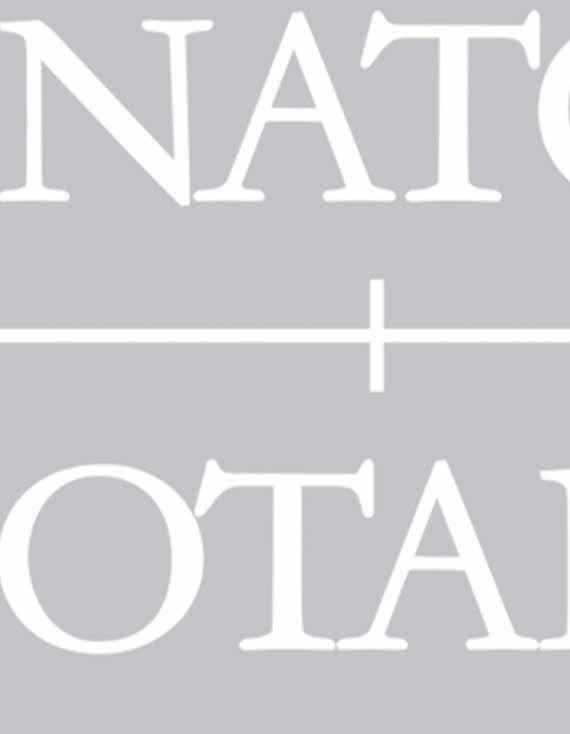
identifying this “arena” as a meeting point for innovative solutions in cyberspace. The 2016 Warsaw summit focused
of operations” (like land, air and sea). It approved a shared commitment to the development of cyber defence in terms of resources, capability building and training. In the same period, NATO signed a joint declaration with the European Union indicating cyber as one of the vital areas of collaboration. It recognised the principle of applicability of International Law to this new domain.
has been an opportunity for a refreshed momentum thanks to the awareness of new “emerging and disruptive technologies”. These new technologies systems, quantum technologies) will guide the paradigm shift of the concept of “mass” in the future “battlespaces”, where the technological advantage will prevail over the traditional military effort. Cyber threats will bring more and more risk factors as these technologies evolve. For this reason, the Alliance has issued a doctrine for cyberspace operations and, during the 2021 Brussels summit,
approved a new “global cyber defence policy”. In a statement on the summit’s sidelines, NATO leaders said that the Alliance is determined to use its full range of military capabilities to deter and counter cyber threats, including those conducted within “hybrid campaigns”. Furthermore, acknowledging that cyber activities could be considered armed attacks, the Alliance reiterated the need to “prevent, detect, mitigate and respond” to vulnerabilities and intrusions. More effective integration between the Allied States and collaboration with partner countries, international organisations, industries and academia will be essential. In the face of an evolution that recognises cyberspace as a growing has NATO shaped?
Various political, military, and technical authorities/institutions have developed the Alliance’s cyber defence policy while considering that individual states hold leadership in cyberspace. The North Atlantic Council exercises the main political authority in managing

committees on cyber security for strategic planning and executive
management of networks, as well as for technical and defence issues. The Cyberspace Operations Centre for operational matters, ensuring the Alliance that operations are more resilient to threats. For technical aspects, the NATO Communications and Information Agency is the leading communications services manager, with its own Cyber Security Centre as a specialised sector hub.

are essential in exploring opportunities and mitigating risks in this new in Oberammergau (Germany) is responsible for cyber defence training to support operations. Two other schools are the NATO Communications and Information Academy in Oeiras (Portugal) and the NATO Defense College in Rome. Finally, the Tallinn accredited body that deals with research, interdisciplinary expertise covering technological, strategic, operational and international law areas. For this last aspect, the Centre
 Rivista Militare / Selection of 2022
Rivista Militare / Selection of 2022
involved a group of experts to develop binding academic work that provides a vision of the application/applicability of
in the cyber domain. This manual, now in its 2.0 edition (the centre recently launched the 3.0 project), has become a valuable resource for “legal cyber issues, considering the rules of international law governing cyber incidents.

This is the cyber today, while its tomorrow is projected to consider cyberspace a “place” of opportunities to gain an advantage over competitors and opponents, changing the traditional centres of gravity and strengths. Cyberspace also implies risks, with hybrid threats that undermine the stability and security of nations, with actors hidden within a “space” that allows anonymity and deception. It is a path and not a point of arrival that the Alliance is facing, trying to achieve ever greater effectiveness of the military instrument in the information age, where the “restlessness” of cyberspace activities opens up vulnerability but, at the same time, offers opportunities to transform and improve.
“La difesa cibernetica nei Paesi NATO: modelli a confronto” [Cyber defence in NATO countries: models compared] (Istituto Affari Internazionali. Alessandro Marrone ed Ester Sabatino ed. 2020).



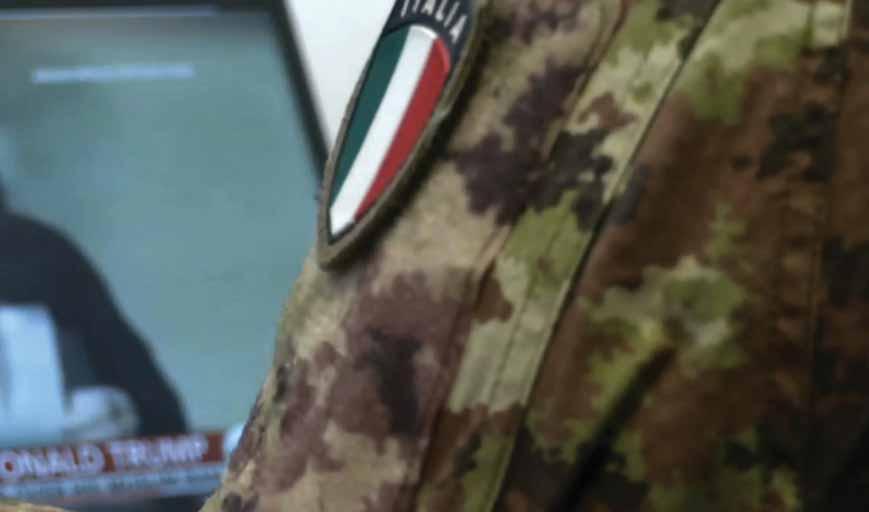
and summit), NATO Communications and Information Agency and NATO Cooperative Cyber Defence Centre of Excellence.



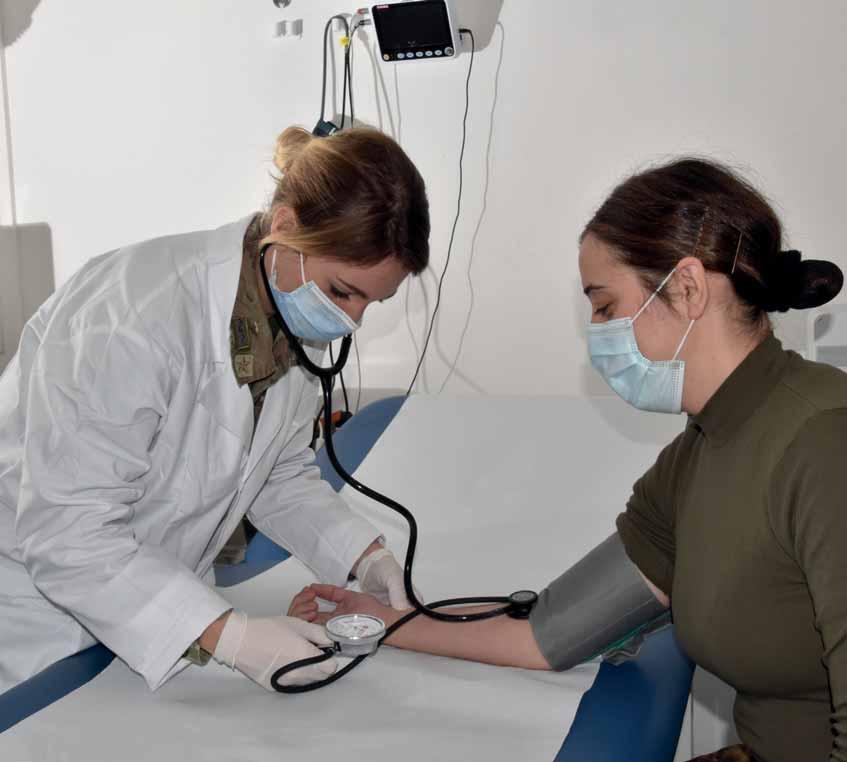
Captain Laura Cretì talks about her work
Captain Laura Cretì talks about her work at the Lancieri di Montebello regiment at the Lancieri di Montebello
by Paola Pucci Paola PucciCaptain Laura Cretì puts her heart into it every moment of the day, and with each of her patients, she uses all her energy for what she considers a real mission. Starting

Lancieri di Montebello regiment and has become a point of reference for the 800 military personnel of the structure. After passing the competition to be admitted to the Military Academy of Modena, she graduated in Medicine and Surgery to be part of the Medical Corps; commissioned Lieutenant, she began her engagement with the regiment.

“I am aware that being a medical mission in the mission, in which the Hippocratic oath that every doctor takes joins the oath of loyalty to the homeland for a commitment of double value and responsibility”, underlines Captain Cretì. After almost four years of employment, what is your balance?
What is your relationship with “military patients”?
What is a typical day like for a




















You have a special memory of summer 2020 as you were in Lebanon.




Another emergency, which involved everyone, has the infamous name of Covid: how did the regiment experience the crisis and all the related problems?

What are your commitments and prospects for the future?












 by Rodolfo Bastianelli
by Rodolfo Bastianelli
The majority spoken language divided by city, town and village councils
Result of the 2001 ukrainian census

Among the many issues around the Ukrainian crisis, ethnicity is one of the most complicated.
Russians
speaking populations in Ukraine dates back to the 14th century, the beginning

truce with Poland, the Tsarist Empire incorporated eastern Ukraine and the city of Kiev. Subsequently, due to the two
Galicia became part of Austria while Podolia and Volhynia were annexed to
too. After the First World War, Ukraine became a Republic of the Soviet Union.
“Holodomor”, the event which marked its national identity. Determined to break the resistance of Ukrainian farmers who

Stalin initiated a policy of systematic repression of Ukrainian culture and language and requisitioning of crops, which in a short time caused the starvation of a large part of the population. Kiev claims that the extermination carried out by the Stalinist regime caused at least three million victims. It still constitutes one of the issues with Moscow because the Kremlin, while acknowledging its reality, has always denied the Soviet
government’s intention to commit the genocide of the Ukrainian people. The events during the Second World War were no less relevant. Hostile to the Soviet regime, Ukrainians in the western regions welcomed the German troops, convinced that Germany would facilitate the birth of an independent Ukrainian state. An expectation soon turned out to be unfounded: in August
Bucovina returned to Romania, and the Ukrainian territory was organised as a “Reichkommissariat”.
In this scenario, Stepan Bandera, the controversial nationalist exponent, appeared. The Ukrainians consider speaking population a Nazi responsible for atrocities against Russians, Poles
a guerrilla war against the Red Army with the “Ukrainian Rebel Army” (UPA), which would engage the Soviet units
event was the handover of Crimea from Russia to Ukraine, decided by commemorate the 300th anniversary

However, historians believe that this happened for quite other reasons. The reference to the Treaty of Pereyaslav
Russia and Ukraine, is devoid of historical and legal value as it did not contain any connection with Crimea, which became part of the Russian Empire only one hundred and thirty years later. Historians believe that Khrushchev took this decision to strengthen the Soviet
central power’s control over Ukraine. He relied precisely on the presence of over 800,000 Russians who would join the Ukrainian SSR from that moment, thus implementing the same policy adopted in the Baltic republics where the Kremlin had settled Russian speakers to extinguish the autonomist aspirations of Estonia, Latvia and Lithuania.
Settled in the Crimean peninsula, where in 1443 they founded the “Crimean Khanate”, Crimean Tatars heavily suffered the consequences
They became a minority in just over a century due to the expropriations and deportations carried out by the tsarist regime. The situation of the Crimean
the USSR, an “Autonomous Republic of the Crimean Tatars” was established within the Russian RSFS, while on the cultural level, the use of Tatar names was readmitted.
of the Stalinist regime led to a new introduction of the Cyrillic alphabet. The Second World War deeply marked the fate of this population. In the summer
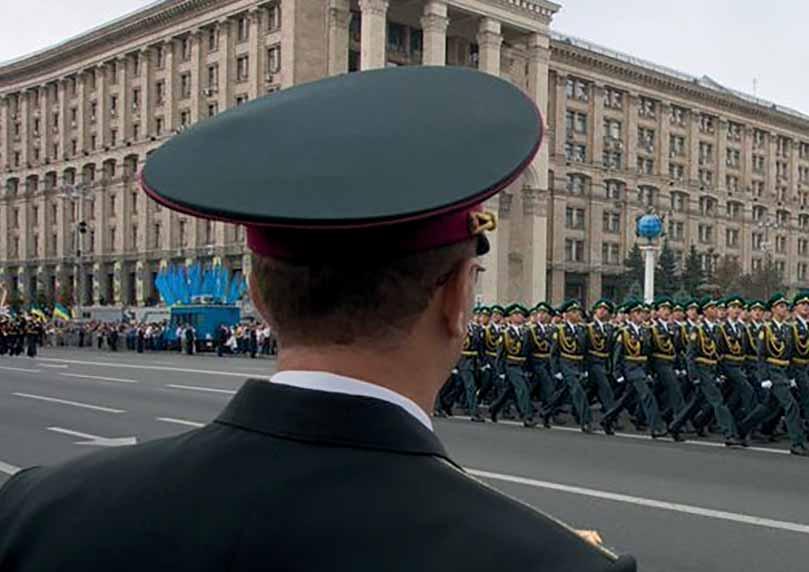
the Germans because of their profound hostility towards the Soviet regime, a behaviour later used by Stalin as a pretext for carrying out harsh repression. Accused of being “traitors”, almost two hundred thousand Tatars were deported to Central Asia, their populations from central Russia, and, above all, they were deprived of all rights. A partial restoration was granted
the Tartars and Volga Germans the right to resettle in their lands of origin. Currently, according to estimates,
peninsula’s population. While looking unfavourably at the return of Crimea to Russian sovereignty, they avoid taking an attitude of confrontation towards Russian speakers. Similarly, given the common Turkish ethnic origin and
Sunni Muslim religion, Turkey has expressed its closeness to their claims while maintaining a very moderate and energy ties with Moscow.
According to the 2001 census, the Hungarian population in Ukraine is slightly over 150,000, concentrated almost entirely in the Transcarpathian region. Hungarians became citizens enjoy several rights, including being taught in their native language in bilingual schools, displaying the Hungarian
one in public buildings, and using the Magyar language on road signs.
Five years ago, however, the Kiev Parliament approved a controversial law stating that education must be given in Ukrainian. This provision overturned the law introduced in 2012, under the presidency of Viktor Yanukovich, which allowed the use of national languages to different minorities if, in a district, they were
According to the 2001 census, Poles living in Ukraine numbered 144,130. Most of them reside in the regions of Khmelnytskyi, Lviv, Zhytomyr, and Kiev. Although the Polish presence can be traced back as far as 1030, it was only around the seventeenth century that many arrived in Ukraine in search of better opportunities and living conditions. In the following years, their
half a million Poles were residing population. With the worsening of the Soviet regime, their situation worsened
Poles were deported to Kazakhstan or became victims of the Stalinist purges.
the new Ukrainian government passed the minority rights law, under which Poles were allowed to use and receive education in their language. However, in later times many provisions of the law were considerably limited. Following
the Orange Revolution of 2004, Kiev granted the Polish population the right to use a particular identity card that allows multiple entry visas to Poland. The Warsaw government appreciated this measure, considering it the signal of a new phase in bilateral relations. The position of the Romanian minority is more controversial. According
151,000 Romanians in Ukraine, while Bucharest estimates their numbers at 400,000, including the over 250,000 Romanians of Bessarabia, whom Kiev considers Moldovans, a distinct minority. The law approved by the Bucharest Parliament for granting Romanian citizenship to Romanians from Bessarabia (Moldavia) and northern Bukovina has raised controversy. This law made it easier to obtain Romanian citizenship for people who resided in those regions came under the control of the USSR – if they could prove that they lost it against their will. This measure aroused protests from Ukraine, whose legislation does not provide the right
to dual citizenship and considers this as proof of Romania’s expansionist ambitions. A new issue arose last November over Kiev’s decision to declare the Moldovan language distinct from Romanian. Bucharest criticised this decision, claiming that Moldova’s recognises Romanian as the country’s Bulgarians
The minority in Ukraine is the largest Bulgarian community abroad. Bulgarians settled in Ukraine between the end of the 18th and the beginning

in the Odessa district, where they city of Bolgrad. Tensions in relations
2020 over the reform that reorganised Ukrainian local administrations, which, according to the Bulgarian Parliament, put the rights of their compatriots at risk. This framework can provide a further key to understanding the current situation in Ukraine.














 by Giuseppe Diotallevi
by Giuseppe Diotallevi
The time will come to study the current crisis in Ukraine from a purely military point of view, but to do so now would mean falling hostage to the dialectical confrontation between the two opposing narratives without being able to understand reality and ending up becoming the sounding board of one or the other party. Perhaps it is better to understand why we abandoned the doubt by falling prisoners of the prejudice that, at any cost, tried plausible: the impossibility of war. At this stage, perhaps, it is more useful
by: “rarity, extreme impact, and retrospective (though not prospective) predictability” (1), a “Black Swan”. A series of misleading considerations
“platonic fold” of Taleb clouded the ability to predict: Putin, after 31 years, just wanted to recover his role and
an expedient to speak on an equal footing with the USA. The “Platonic fold” acted through mental categories corroborated by historical experience and academic principles.
A country’s strategic potential is based on three key factors: military, economic and demographic power; therefore, with a GDP about half of the Italian one and a collapsing demographic, Russia did not have the means and, therefore, the possibility of waging war. This reasoning has led us to exclude
So far, we have considered only the quantitative aspect, to which historical considerations must also be added.
(2), works and allows those who apply it to gain small cumulative advantages
would break the threshold of tolerance of the international forum, putting an end to the usefulness of this strategic approach and sliding inevitably into an armed confrontation on a large scale. The Artichoke Strategy, therefore, ensures advantages only if it does not
A classic example is the conduct of Hitler Germany before World War II:
Anschluss of Austria, the annexation of the Sudetenland was the second, and the third leaf was the invasion of Poland: it did not work because it broke the Allied tolerance threshold leading to World War II. The inductive logic led to an overlap
the conduct of Putinian Russia,
artichoke, Georgia 2008 and its recognised Russia’s right to intervene to protect citizens; the second leaf of the artichoke, Maidan events and consequent annexation of Crimea in 2014. From this comparative analysis, conducted in the light of “inductive” logic, it seemed natural to conclude
These considerations have “led” to exclude the possibility of invasion, considering Putin and his entourage too rational actors to start an impossible war. For a problem of knowledge or, better said, of presumed knowledge, we have transformed the impossible into “unpredictable”.
In other words, we thought that Putin would not invade Ukraine because this choice seemed irrational.
mistake because strategy actually responds to its own form of rationality
or, better said, to logic. Certainly not the Cartesian linear logic: calculation inspired by the effective allocation paradoxical logic (3). The linear positivist approach, based on the certainty of being able to predict events by simple induction from the past, has no place in the strategic logic dealing with complexity. The typical tools of the Cartesian approach, based on decomposing the main problem complexity (4).
compress complexity, with the inevitable consequence of not understanding reality and not making a correct prediction. Hence the genesis of the surprise, the worst of surprises, namely the strategic one. In this regard, it is correct to clarify that the etymology of the word ‘strategy’ refers to the stratagem based on deception. Therefore, it is in the very nature of strategy to recognise surprise as a power multiplier and an element functional to its aims. Strategic surprise is assured when the paradoxical logic leads one to choose the option that develops along the line of “least probability” (5).
Hence the need to admit that Putin “played his game” by choosing this line and knowing how to create the conditions for a strategic surprise. At this point, the problem is linked to the understanding of reality: despite American intelligence, media, and think tanks had monitored the presence of about 120 Russian batal’onnaya takticheskaya gruppa (battle groups) deployed on the border, and they had announced a possible invasion even indicating the dates, why have many of us ruled out a priori the possibility of
understand reality, denying what was now evident?
We have not considered the US predictions because they are excessively biased and inspired to
However, intellectual honesty must lead us to deepen and try to understand. Why have we relied so heavily on our “inductive” reasoning by preventing intuition from emerging? (6).
power of cognitive bias that made invisible what was actually appreciable before it all started.
The bias is based on what Marc Bloch calls “the imagination of the masses” who wait only for plausible
“is the mirror in which the collective consciousness contemplates its becomes possible, our ability to question our beliefs is permanently induced certainty.

Deepening some aspects of strategic logic and its predictive functions requires considering the psychological
sciences should be placed at the service of both prediction and strategic paraphrasing him, the cognitive sciences highlight the danger of factors such as beliefs and illusions for strategic an objective examination of reality by this point, the risk is not only to sort information by accepting as true only (Mlodinow) but, even worse, generate a distorted perception of reality (Bloch). In short, it was a trap that was inspired
the unconscious system, risking that excessive rationalisation will discard a good idea or, as in this case, a plausible was, therefore, a question of falling into the worst of traps, the one we built by

Like the Gauls who opposed Caesar, we followed the general logic that “men willingly believe what they wish to be true” (10).
tore, Milan 2014, p. 11 N.N. Taleb, The Black Swan. The Impact of the Highly perback Edition (2nd ed.) p. XXII.
ling & Kupfer, Milan 2018, p. 152 (Italian edition).
Donzelli publisher, Rome 2004, page 100.
Franco Angeli, Milan 2004, page 128.
(3)
(Manual of strategic studies), Franco
(10) G. Cesare, Commentarii de bello Gallico, book III, 18, 6.
by the desire for certainty that leads to simplifying reality. Experiences and beliefs determine expectations


are two of the most important and the world rock music scene. But perhaps not everyone knows that, in addition to being British, they have in common a past linked to our country, a very close root in central Italy and precisely in Lazio, at the time of the Second World War.

lead singer of the Australian band

UK. He joined the band after Bon
powerful and biting voice is an icon that has characterised all of the band’s biggest hits and hundreds of concerts around the world until today. Brian says he got his voice from his father, Alan, Sergeant Major of the British Army, Durham Light Infantry Regiment. Brian inherited his love for our country from his mother, Ester De Luca. Yes, because Ester De Luca, an Italian, met her future husband Alan in Rocca Di Papa during the Allies’ advance after the landings in Sicily, Salerno and Anzio. Rocca di Papa is a mountain town in the Castelli Romani area, where Brian still has relatives and spends a holiday period at least once a year. Who knows if he didn’t also inherit
from his mother the spirit and strength he transmits in music: Ester De Luca actively participated in the











revealed to Al Murray’s microphones little bits of information, she would secretly pass them to the Allies. At her farm, underneath the chicken run, unbeknownst to her three brothers, all of them Blackshirts, there was a hideout where my mother hid the downed Allied pilots for a couple of days. Then, she helped them to reach Switzerland to get out of the country”.
Great Bookham, near London, is one of the founders of the famed Pink Floyd, with whom he found space as bassist, producer and singer with Syd Barret (before) and David Gilmour (after). Although his artistic career is closely linked to the English band, from which release of the album The Final Cut, Roger Waters continued triumphantly as a soloist. He released numerous albums and achieved worldwide success. Eric Fletcher Waters was the father of Roger, Second Lieutenant of the 8th Battalion of the British Royal Fusiliers (Company Z), who landed

near Aprilia on the following 18 months old, after a counterattack by German tanks on the Allied bridgehead. This loss profoundly marked the life of the artist, who has dedicated to his father songs like When The Tigers Broke Free, like Free Four, where a passage reads, “You are the angel of death // And I am the dead man’s son // And he was buried like a mole in a fox hole.” The most ardent fans of Waters even believe that in all of his songs, there are references to his father. In addition, Roger’s activism, demonstrated over the decades against all wars and forms of oppression in the world, seems to originate in his father’s loss, snatched from him by the madness of war without even the comfort of receiving his remains. In a documentary on Wish You
Were Here, he said, “I wanna be in the trenches of life. I don’t want to be at headquarters, I don’t wanna be sitting in a hotel somewhere watching the world change, I want to change it. I wanna be engaged. Probably, I might say, in a way that my father would approve of”. Eric’s body was never found. For many years, all that remained of Roger’s father was a plaque with his name written on it, in the Commonwealth War Cemetery of Cassino dedicated to all the British fallen in Italy, a cemetery that Roger has visited on many occasions without knowing exactly where the facts actually happened and where Eric’s remains were. To
family, visited those places and inaugurated a monument dedicated to his father in Aprilia. On February 18 of the same year, exactly seventy years after the death of Second Lieutenant Waters, Roger received honorary citizenship of Anzio, further welding the deep bond with our country.
A few kilometres apart in Lazio, in the same years and under the same circumstances, the roots of two great artists saw the light and made them what they have become, giving endless beauty and passion to the whole world. It is comforting to see that humanity somehow has been able to draw glimmers of hope from the ruins and the disaster of man’s madness. The bitterness and hardship of war experienced by the fathers of these two artists, just 24
Shindler, representative of the British Army Veterans Association. He managed to identify the precise place of Roger’s father’s death and the circumstances in which it occurred. Second Lieutenant Eric Fletcher Waters fell near Aprilia, but his body could have been destroyed or buried on the spot without reference. In 2014 Roger, accompanied by all his

kilometres from each other, has become the hope that now walks on the legs of their sons.

https://www.virginradio.it/news/
html
https://www.repubblica.it/spettacoli/ people/2013/10/10/news/roger_
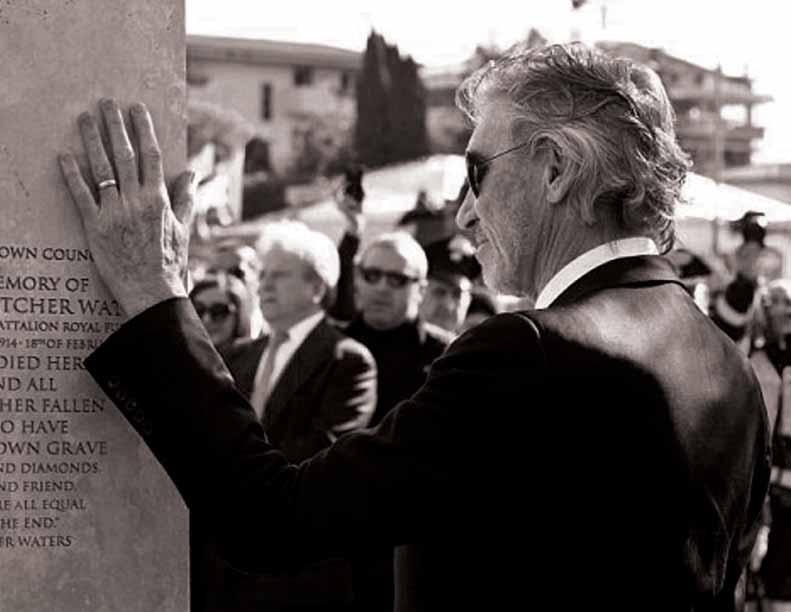







 by Emilio Giglio Emilio
by Emilio Giglio Emilio
Is it still relevant to move armies using the railways? The changing international geostrategic situation has made this type of transport increasingly advantageous. Moreover, the Italian Army is a leader among NATO member countries in this sector. Moreover, perhaps not everyone knows that the debut of the construction of military railway lines, entirely Italian: it dates back to 1855, during the Crimean War. Although the “strategic railway” is built exclusively for military purposes, nowadays, strategic transport travels
on railway lines, which are used daily for the present day, railway transport has proved unbeatable in its ability to move heavy and bulky loads, vehicles and personnel over long distances, even at relatively high speeds and low costs. Over the decades, however, this type of use has progressively decreased with the progress of military technology and, particularly, the increase in the air recent study by the US Government the US Congress, rail transport has

te per scopi militari, oggigiorno il
to utilizzare aerei o le strade per ti, con tempi molto lunghi, mentre ora la situazione sta cambiando e la rete ferrata.

tanza di questa rete per l’area, evidenziato anche dal summit tenutosi a Bruxelles nel giugno
po di potenziare la connessione ferroviaria tra i diversi paesi. Si è legare gli stati baltici attraverso la
peramento di interruzioni di linee ferroviarie, saldature allumino ragliati, favorendo il confronto tra le differenti procedure delle varie
Nel caso di impiego reale della gna militare l’Italia sarebbe l’unica nazione all’interno dell’Alleanza in ne di infrastrutture, il montaggio di
tando lo smistamento delle truppe e della logistica provenienti dalle basi NATO di Germania e Polonia. Il trasporto su rotaia e quello su





te con gli altri sistemi di trasporto permettendo di raggiungere tutti i luoghi del pianeta. Pensiamo, ad esempio, a un trasferimento di equipaggiamenti dagli USA alla Penisola Scandinava: i materiali
rebbero trasportati sulla ferrovia roporto di Riga al porto di Tallin, qui imbarcati e successivamente raggiungerebbero la destinazione finale. L’impiego di più tipologie ca consolidata. La “Rail Baltica”
tare, non può essere appannaggio talia fornisca all’Alleanza Atlantica
que la collaborazione tra i diversi paesi membri. A questo proposito, il reggimento Genio Ferrovieri già promuove attività multinazionali con gli omologhi inglesi, olandesi, tedeschi e spagnoli. Ogni anno si svolge l’esercitazione TURNOUT durante la quale vengono costruiti
ways to move forces and materials to and from the homeland.


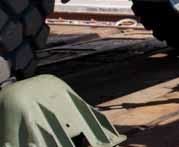
Since the end of the Cold War, over the years, NATO’s centre of gravity has gradually shifted to the EAST.
negligible element, assuming greater importance following the Russian invasion of Crimea in February 2014.

integrated railway system and would be able to supply and move troops


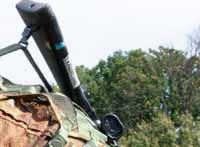
while the situation is evolving for the Alliance. The allies, until recently, would have had to take a very long time to bring reinforcements and supplies using aircraft or roads, while now the situation is changing, and work is being done to strengthen the
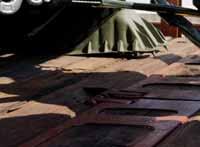



railway network. The awareness of this network’s importance for the area, also highlighted by the summit held in
strengthen the railway connection between the various countries. A plan has been developed to connect the Baltic states through the “Rail

the sorting of troops and logistics coming from Germany and Poland NATO bases.


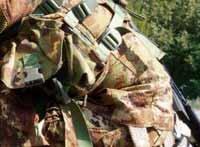

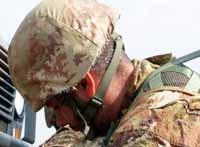
Rail and road transport integrate perfectly with other transport systems, allowing you to reach all places on the planet. Let’s think, for example, of an equipment transfer from the USA
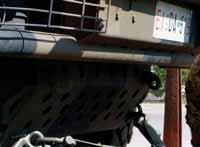

to the Scandinavian Peninsula: the materials would arrive by plane, then they would be transported on the “Rail Baltica” railway (or road) from Riga airport to the port of Tallin, embarked here and subsequently reaching the types of carriers is now a consolidated practice. The “Rail Baltica” is a railway nation cannot manage. Even though Italy provides the Atlantic Alliance the activity still requires collaboration between the various member countries. In this regard, the Italian Railway Engineers Regiment already promotes multinational activities with its English, Dutch, German and Spanish counterparts.
 Rivista Militare
Rivista Militare
Every year the TURNOUT exercise takes place during which sections of tracks and switches are built and repaired, bridging is carried out to overcome interruptions in railway lines, aluminium thermal welding, and
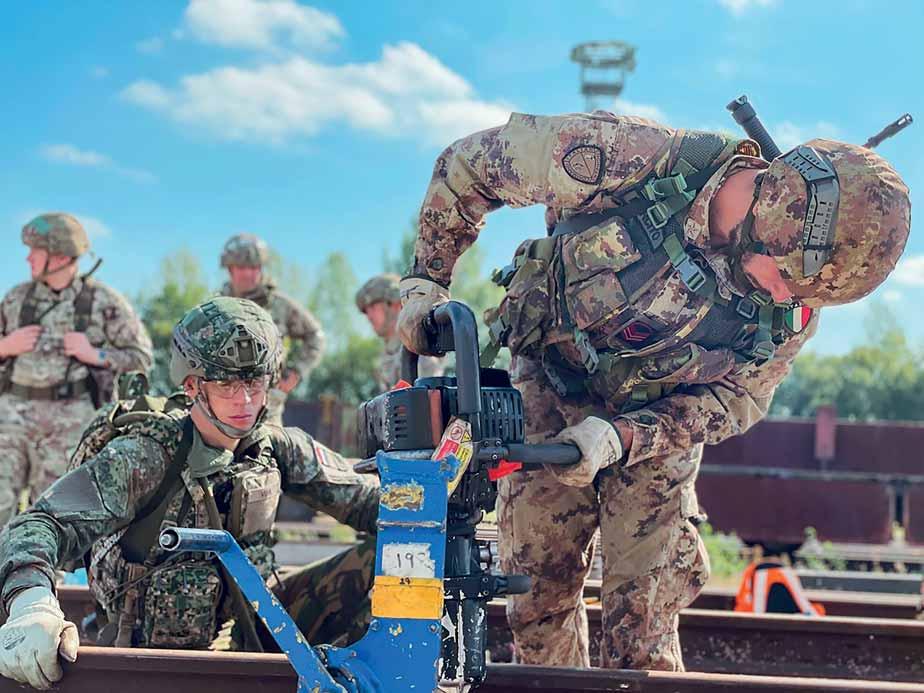
the comparison between the different procedures of the various units, also promoting a valuable exchange of skills.
In the case of the actual use of the “Rail Baltica” during a military campaign, Italy would be the only nation within the Alliance able to manage the railway operation, the maintenance/repair of infrastructures, the assembly of


bridges and railway loading platforms, employing exclusively military personnel and playing a key role within NATO, as has already happened in Bosnia and Kosovo. Thanks to a unit of specialists such as the Railway Engineers Regiment, our Army is a reference element of the entire Alliance unload materials autonomously, even to guarantee intermodal transport in impervious and not equipped areas. In addition, to deploy their units in the most disparate places on the
experimented with, such as a recently designed modular loading platform;
these can be mounted on any railway gauge and allows the movement from road to railway (and vice versa) of light wheeled vehicles, tracked vehicles, propelled artillery.
In the 21st century, rail transport remains lively and, in alternating phases, is rediscovered and enhanced, so much so that it is considered the strategic transport capable of contributing campaigns. Many NATO countries have lost this capability, others have never developed it, and others would like to acquire it and look to Italy and its Army as a reference model.


 by Andrea Spada and Livio Cavallaro
by Andrea Spada and Livio Cavallaro
From the siege of Troy to the use of drones, how have urban operations changed, and what developments will they have in the future? In the past, cities were mostly besieged during wars, and there was not always World War, things have changed, evolving until considering metropolises about it, let’s interview Lt. Col. Livio Cavallaro, one of the leading experts on combat in this type of environment.
Considering what has happened and is happening in Ukraine, how has the concept of urban warfare or urban operations changed, or how will it necessarily have to change?
regarded as a critical lesson and is being scrutinised internationally. In your opinion, will the problem of challenges in the event of future
It would be suicidal to send tanks or armoured vehicles into urban areas because they can hardly manoeuvre properly. In your opinion, is a highly motivated professional infantry some other component necessary?
Does the empirical rule that attack forces must outnumber the defenders 10 to 1 because defenders have the advantage of knowing the territory still hold?
eight months to defeat a few thousand Islamic State jihadists barricaded in Mosul. In your opinion, are there differences in

the conduct of urban operations in Europe compared to other Army?






modern phenomenon. Do you agree with this statement?





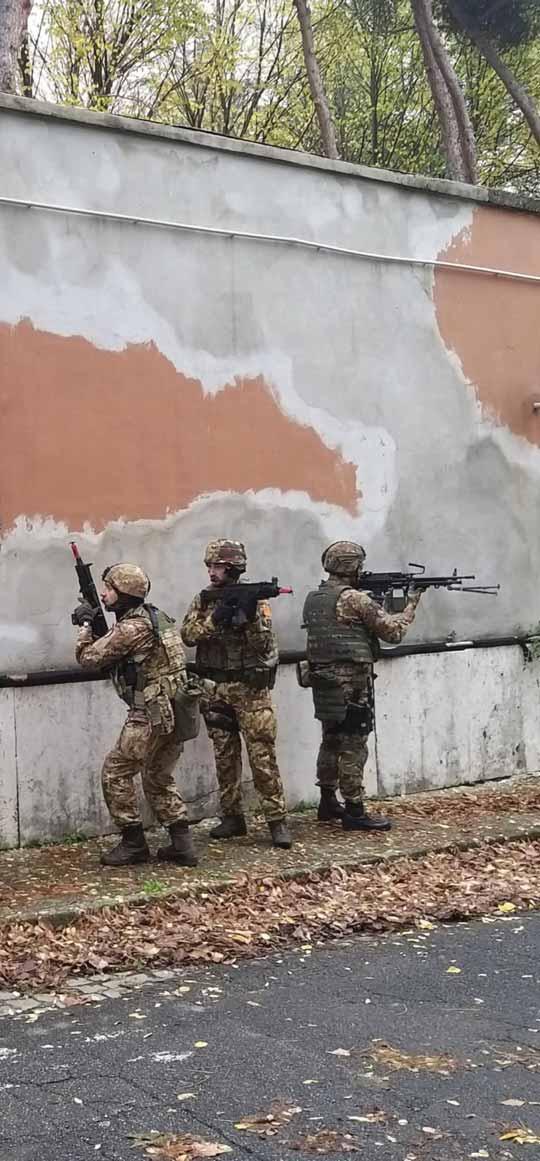 John Spencer, “Modern War Institute” of the American military academy at West Point, says that
John Spencer, “Modern War Institute” of the American military academy at West Point, says that

In less than a year and a half, the Savoy army dispersed its fame and tradition matured over the centuries.
lacklustre episodes of Custoza and campaign for Italian independence. The tricolour with the House of Savoy’s coat of arms in the centre, a debutant to the skilful General Radetzky’s army. The combativeness, the discipline, the armament, the command, everything that had made the Piedmontese’s amid many complaints in the era of the greatest European upheavals.
reports on the war’s progress immediately appeared. Differences in views among the Army’s leaders promptly emerged, leading to the search for personal extenuating circumstances when not to exchange mutual accusations. A few years had to pass for the matter to cool down and for reasoning to

expressed in the heat of the moment. A distant observer, not yet famous for his association with Karl Marx, but already known as an expert on military
“their heavy batteries, carrying sixteen pounders rendered” the Sardinian of the continent” (1). Half a century after Napoleon’s exploits, that was
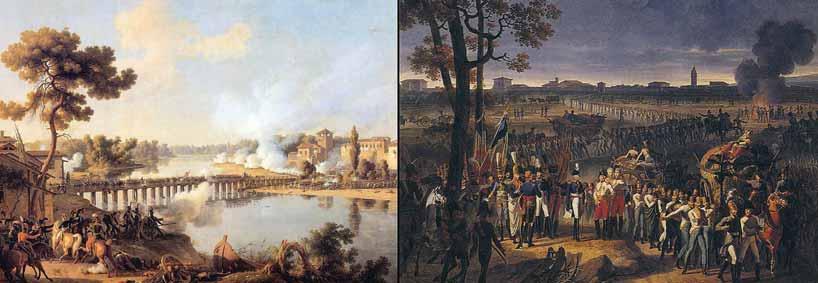
a comment not without indications. Certainly more penetrating than the previous ones, intended to raise ideological and political questions
Austrian reactionary party” nestled in the court of Turin. With a strong but basically consonant accent, Carlo Cattaneo had spoken of the obvious incapacities of a “parade army” and seemed to echo General Eusebio Bava’s statement, who had written that even the sappers’ axes looked more like “simple parade objects, absolutely useless under the circumstances” (3). Of course, something must have happened in the highest cadres of the Piedmontese army if Carlo Alberto had entrusted the command to the Polish
general Wojciech Chrzanowski. In 1855, the “retired major” Ferdinando Pinelli put together the pieces of the Piedmontese military mosaic, which had fallen apart (4). Meanwhile – he said – Carlo Alberto had not been up to the situation: presumptuous, uncertain, distrustful, “pale and haggard, he witnessed a battle with that same recollection with which he heard mass”. He had not been a “king capable of personally leading his armies”; he was not “endowed masses”; he was “inept therefore in the council”. Going to war against a power like Austria with such a leader did not bode well.
uncertain terms that, while Radetzky had kept the troops in exercise even in the most peaceful years, the Piedmontese had essentially settled down among the decorations of their uniforms, reaching the test of the
As often happens to unworthy heirs, themselves in the martiality of their ancestors but which was by now usurped fame. The men who had waged war between the eighteenth and nineteenth centuries were no longer there; if there were still any, they could no longer mount horses
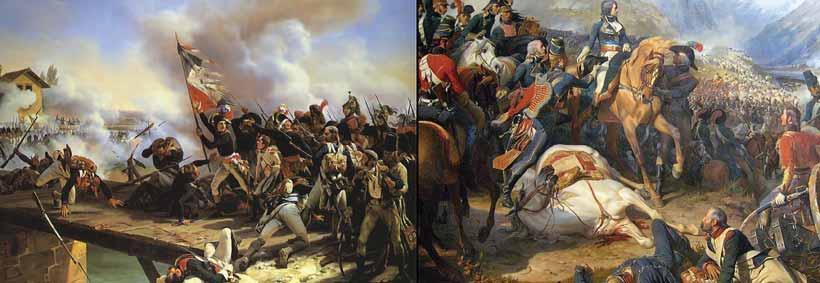
detested privations, and thought only of personal care. They had no knowledge of the use of weapons. They had believed in a career entirely now baulked at rushing into action. were “few, ignorant, some illiterate, and if not old, worn out by the use of alcoholic beverages and incapable of that sense of dignity which makes any military rank appreciated”. The cavalry
in men, no knowledge of service…”.
“The sappers of the Engineers were [...] The artillery was not numerous enough, but excellent both in material and personnel: brave, educated, young, full of honour and desire to distinguish themselves; likewise, the gunners above all the Army…”. In short, here are the results of a profound hostility that the most conservative Piedmontese aristocracy had nurtured towards “cultured” arms in the second half of the eighteenth century: that is, towards those men who, not being noble by birth, had to rise through their studies. These men had to work to emerge since they did not have lineages that generously bestowed positions of command, only that one knew how to fence and
reactions of great contempt had taken place at Turin’s court and in the Army’s ranks towards those technicians specialised in the ars mechanica, so distant from the aptitudes and prospects of a gentleman in uniform.
almost say, tactical notions”: they had not studied the terrain, did not know their men and even ignored the army organisation. They shunned fatigue,
As if centuries hadn’t passed since the mythical art of war gained fame, sword in hand and tournament lances, as if the knights of yore could continue to instil the foundation of the Theoretical and
military status of engineers, architects, chemists, mathematicians, hydraulic engineers, and physicists. They were and had to remain in an auxiliary, class position. Secondly, it had been expected for decades that the guns remained nailed to the fortresses: how to contest the noble gesture of the swordsman? Emanuele Filiberto at the end of the sixteenth century, then Carlo II, not to mention, in Europe, Carl Gustaf King of Sweden, or Frederick II King of Prussia up to Napoleon, had been much more advanced in Casimiro Gabaleone di Salmour presented a project for the construction of regimental guns, arguing that “le service que peut rendre à une armée une nombreuse artillerie, lestement équipée, et servie avec vivacité, est en parler” (5). Therefore, this project was neither pioneering nor daring, and, nevertheless, it was rejected: resubmitted in 1855: it was rejected artillery was divided into the Royal Artillery Corps and the Battalion Artillery Corps. However, this branch had no relevance in the structure of the army. Field artillery existed on paper
employment.
The wage of war required at least notions of ballistics, architecture, and engineering, integrated with other knowledge of military techniques. This idea could not penetrate the Army’s top ranks. A few positive aristocrats of more cosmopolitan backgrounds tried to
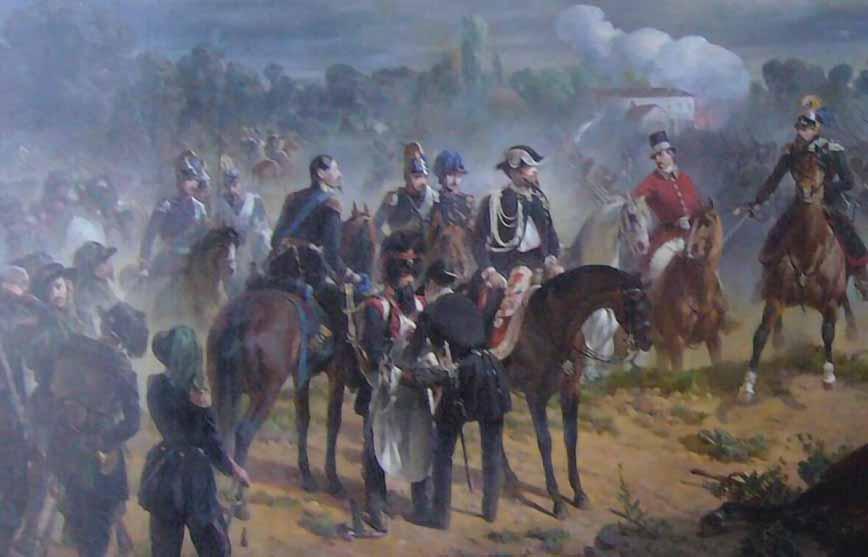
intended to control the Alpine borders was formed, some compulsory courses
smattering of elementary mathematics,
the Commendatore de Châtillon had


proposed to create a military library and
“feared that when the experience made shown the study’s usefulness, they too would be forced to do something contrary to their inclinations” (8). In the eyes of a young man of noble ascendancy, the
Walter Barberis teaches Modern History and Methodology of Historical Research at ling classes in the modern age and, in particular, “The Arms of the Prince. The Savoy
“The Annals of the History of Italy 18. War and Peace” (Einaudi, 2002), “I Savoia” the essay “The Need for a Homeland” (Einaudi, 2004 and 2010) and “History without
study was not only incompatible with social rank but inserted elements of meritocracy that disrupted the social hierarchy. It was almost obvious that better than one “simply” born noble. Therefore, the artillerymen and engineers cultivated studies of a
Practical Schools; they were the Turin Academy of Sciences founders
importance, those men and their cultured research remained on the margins of the military organisation. More often, they were successful by transferring their machines to the
characters – Lagrange, to name one – but the nobles who occupied the command posts of the Piedmontese Army pretended not to notice.
the Napoleonic armies occupied Piedmont, the Army was dissolved, except for the artillerymen and engineers, who were all integrated
French army. In those years, the
But many were now out of the game or in irrelevant career and function positions. Savoy Piedmont, rich in history and tradition, presented itself at the appointment with the Italy in these conditions. And so it was defeated.
(1) See F. Engels, The armies of Europe, in “Putnam’s Monthly”, no. XXXVI, December 1855 (now in K.Marx and F. Engels, Sul Risorgimento italiano, edited by E. Ragionieri, Rome
(2) C. Cattaneo, Dell’insurrezione di Milano nel 1848 e della successiva guerra, in Il 1848 in Italia. Scritti

(3) Relazione delle operazioni militari dirette dal generale Bava comandante
il primo Corpo d’Armata in Lombardia nel 1848, Torino 1848, p. 54.
(4) F. A. Pinelli, Storia militare del Piemonte in continuazione di quella del Saluzzo, cioè dalla pace d’Aquisgrana sino ai dì nostri, Torino
(5) “the service that a large artillery, lightly equipped and served with vivacity, can render to an army is so to speak of it” Progetto del Cavaliere di Salmour per la costruzione di cannoni
Archivio di Sato Turin (AST), section I, Military Matters, General Artillery
(6) Sentimento del Cavaliere di Salmour sovra il progetto già stabilimento di cannoni di reggimento,
militaires par le marquis de Brézé adjutant général de cavalerie au service du Roi de Sardaigne, à Turin, chez les frères Reycends, MDCCLXXIX
(8) Cfr. Pinelli, Storia militare del







 by Elio Cimiraglia
by Elio Cimiraglia
 Rivista Militare
Rivista Militare
• • to a maximum of 16 passengers, connected to the aerostat in such a way that the entry/exit opening is always positioned downwind with respect to the point where the aerostat is hooked up to the winch. The intended limitations of use of the system include a wind speed below 30 knots (55 km/h or 15.5 m/s).
Who would have thought that the old, picturesque airships and hot air balloons could inspire the most modern training techniques? Well, so it is. The “Tethered Gas Balloon for Parachutists
as Aerostato Vincolato (AV), has been available to Brigade “Folgore” since 15 Air Force and the Army conventional activities.
The AV is a unique system in terms of size and load capacity. Although Army’s Parachuting Training Centre in Schaffen has been using a similar
The new system is marketed by ASIA Equipaggiamenti of Anzio (RM) and produced by Lindstrand Technologies
Not surprisingly, its owner, engineer Per Lindstrand, is known worldwide for a long series of records connected to the earth with “balloons”. The operating principle is the same as that of old airships and hot air helium (which is lighter than air and by Archimedes’ principle, is buoyed
up according to the volume of the displaced air.
The system is equipped with emergency procedures/systems which protect the crew in case of breakdown/ malfunction. Although the airship is not manoeuvrable, it can, in extreme cases, lose altitude by discharging helium to reduce the lift (the gas loss reduces the pressure of the balloon and increases wind resistance).
aircraft” as it is a “machine used for transporting men and equipment in the air, for military purposes”. Consequently, it went through a long


the European Union Aviation Safety Agency and by the Directorate of Aeronautical Armaments and Airworthiness (DAAA) to guarantee its airworthiness and safety (also for the


The system is an absolute novelty in the national military aeronautical landscape. A multidisciplinary and joint approach has been adopted. A package of ad hoc rules/directives has allowed the “Folgore” Parachute Brigade personnel, already possessing
the AV. For this purpose, authorities
Tethered Aerostat Military Operator (OMAV) and the specially designed Military Aeronautical Maintenance License for Tethered Aerostats.
Lindstrand Technologies Ltd provided the initial staff training and will maintain its responsibility of following the system evolution throughout its operational life as a “System Responsible Company”, also ensuring logistic support for the next three years.
During air training, the basket accommodates:
• Military Operator who also performs the function of “Aircraft Captain” and can activate emergency procedures;
• the Launch Director who carries out coordination functions on board for the paratroopers’ jump procedures;
• paratroopers in training, up to a maximum of 12.
Ground operators include:




• a winch operator, who ensures the ascent/descent of the AV at the end of each launch session;
• the vehicle’s driver, who ensures transport from the hangar to the Launch Zone according to storage
procedures;
• the AV platoon commander, who performs the function of supervisor and coordinator of the activity. To carry out the air launch activity from the AV, the Army has acquired new dorsal and ventral parachutes with an automatic activation device. The French SAFRAN Aerosystems is the producer of this new system, known as EPC (Ensemble de Parachutage du Combattant), which best suits the new launch method (opening and
This new system, already in use in other European countries, offers the possibility of performing jumps at lower altitudes, reducing the parachutist’s vulnerability in the air while allowing

a greater load capacity and a normal descent speed, increasing the operator’s safety. To accommodate the new aircraft and protect it from bad weather, the Army has built a new and imposing structure (L 53 m, W 48 m and H 38.5 m) in Capannori (province of Lucca), near Tassignano. The structure has a modern design, with two large electric front doors with vertical “eyelid” openings, allowing the American composer and theorist of
to give up the past to enter the future”, and this is just one of those cases. The past of the First World War, old tethered observation balloons is back for a new phase of Italian military
parachuting. The “Folgore” parachute Training Centre (CAPAR), will be the pivot of the education/training of all the air troops of the Army, the other Services, and the State Armed Corps. launch “platforms”, a training gym that optimises training times and increases Studies and evaluations estimate that it will be able to perform 15,000 launches with the static line per year. All this will joint training path increasing safety of the Defence Staff hoped for in has lower emissions. It will help
acoustic pollution as part of a broader environment protection project, to which the Army is very attentive. The AV project is also an opportunity
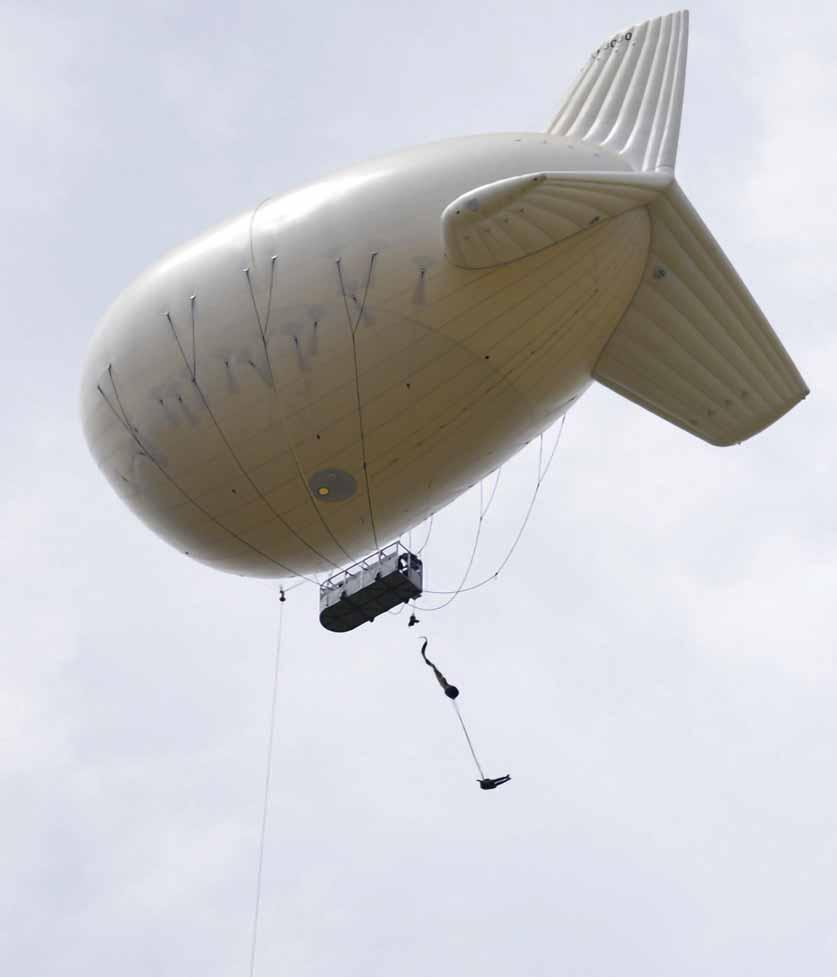
for the Army and the Defence to operate in support of the community. In fact, a fair compromise has been reached between the need to train and the expectations of the territory. We
may even elicit a smile and arouse the amazement of Tassignano’s residents,
BIBLIOGRAPHY
Selection of 2022 / Rivista Militare
mistakes, but it is important to know how to make distinctions.

with a lot of dedicated staff on the set, are unforgivable. Mistakes in
to make a virtue of necessity, can be looked at benevolently, perhaps, even with a smile. In this context, the metal dummy that crashes on the rocks in Lucio Fulci’s “Don’t Torture a Duckling “ is unforgettable, as are the barrels, obviously empty and made of very light material, which kill Mario Brega in Sergio Leone’s “A Fistful of Dollars”. There can be different types of mistakes; technical (like the operators’ shadows on the walls), anachronistic (a car or a TV program produced after the period when the plot takes place), or production (different hairstyles in two sequential scenes).
Of course, with new technologies, production.
When not very obvious, mistakes escape detection by average viewers enthusiasts who know where to look. Some of the most astonishing examples are found in one of the most successful Ridley Scott, a winner of 5 Academy Awards, shot with an exceptional cast and a very high budget.
Well, in “Gladiator”, there are many
mistakes: when the story takes place in Africa, there appears a coral snake that lives in the southern states of the USA and Mexico, regions still unknown at the time of the events. Moreover, in the African desert, coral snakes could a crossbow; a weapon invented in the Middle Ages. There are plenty of stands out above all: they mention the Colosseum, but at the time of the events, the structure was called the Flavian Amphitheatre; the term Colosseum came into use a very long time later.
is anachronistic, “At my signal, unleash hell”, given that the concept of hell in
















when he pictures the afterlife and does it by imagining the Elysian Fields, not paradise. Below, we will enjoy pointing out the most obvious errors in war movies that are among the best known to the public.
“Green Berets
vegetation not exactly consistent with the Vietnamese setting. In fact,
“Miracle in Sant’Anna” (Spike Lee,
of African American soldiers and the relationship of one of them with a child who survived the massacre of Sant’Anna di Stazzema:
1. the head of the marble statue, which is supposed to be very heavy, has an embarrassing weight. The American soldier carries it hanging like an ordinary
2. During the crossing of the Serchio by American troops, the vegetation is far from that of the Lucca plain.
“Black hawk down” (Ridley Scott, USA 2001), the acclaimed director of “Gladiator” once again does not give up on mistakes:
1.

is killed, the Somali who kills him when he comes out of the wall to
2. In the scenes shot in the American base, the sun is often low on the horizon as if it was sunset or late afternoon, while in the scenes set in Mogadishu, which take place at the same time, the sun is high as if it was morning.
3. When a Somali man prays on the beach, he sees the sun setting over the sea. Given the position of Mogadishu, the sun should rise from the Indian Ocean (this Morocco).
“The Hunter” (Michael Cimino, USA
is not without mistakes:









1. during a party, De Niro watches Meryl Streep dance while she drinks almost an entire glass of beer, but after the camera cut, the glass is full.
2. Russian roulette in the prison camp: in the frame with De Niro, it is daytime, while in the one with the Vietnamese, it is dark.






“Saving Private Ryan” (Steven landing as told by Spielberg:
1. during the disembarkation, in particular when Tom Hanks takes off his helmet, the water level changes at each camera cut.
2. Eight soldiers are looking for Ryan. One is killed, but in the next scene, there are still 8 of them.

“Paths of Glory” (Stanley Kubrick, master Kubrick had to surrender to a tiny mistake: although the regiment commanded by Colonel Dax is the by costume designers and tailors.
“Operation Valkyrie” (Bryan Singer, preparations for Hitler’s assassination the scene of the attempted coup, many of summer.

“Apocalypse Now” (Francis Ford











Lucan origins adapts for the cinema
“Heart of Darkness
Conrad. Palme d’Or at the Cannes Film Festival:
1. when Captain Willard argues for fuel, the cigarette he smokes appears and disappears.














2. In the scene on the illuminated bridge, when the boat sets off again, it is preceded by a water trail: the trail left by the boat from











“Mediterranean”(Gabriele Salvatores, campaign, some Italian soldiers arrive on a small Aegean island. Academy Award for Best Foreign Film:
1. the soldiers arrive on the island aboard small boats and make the last stretch on foot in the water. Once on the shore, their trousers are dry.
2. cut the aubergines, the one Abatantuono is holding changes shape with each shot.
“the song of the Italians”, which became the national anthem

All generations need to take care of their discernment skills and know an which hides in comforting forms of tion and rejection of science hide under a layer of an apparent search
everyone can rediscover a sense sion of living a reality perfectly in line with one’s expectations.
ts to Be a Millionaire”. The viewer is led by the hand to the extreme edge ted it has become in society. Unlike what happened in classic necessary to know the answer to receive a reward. The contestant money against one of two options:
thenticity of the incorrect answer. stake, anyone can try to come up
with a credible narrative, combined with some suggestive or moving anecdote tailored to the audience, sitive result.
lenged since 2016 when the Oxford the word of the year. This word can ding to the Accademia della Crusca, “oltre la verità (literally “beyond the logical sense, but with the desire to underline “the overcoming of the truth to the point of determining its loss of importance.”

ving into fake news move from the audiences targeted by propaganda to the dimension of entertainment, undermining the very concept of objective reality even more. Recent news events demonstrate how, from 2016 to today, the truth has undergone a downward spiral. In previous years conspiracies and speculations were limited to the


vide a reassuring feeling of control over terrifying and unpredictable events. Today even the most trivial news is the subject of discussion on the merits of the event itself, up to the point of denying its existence. On the other hand, this involution in the approach to reality perception is
currents have wondered about the relationship between language and reality. These theories studied the ty exert on each other, considering the second. Therefore, to create volves an ontological revolution with innumerable consequences in the short and long term. The situation worsens due to the


phenomenon of echo chambers. This concept refers to the fact that digital and immediate information
sm. Still, on the contrary, it isolates everyone in a “virtual” enclosure where what is appreciated, though not necessarily real, is constantly tition creates the false belief that multiple sources corroborate the mation.


Consequently, one of the effects ty to obtain the broadest possible understanding of the context, in its facts and in the relationships that bind them.


It is, therefore, a question of being
able to identify the truth in a given rally and psychologically accept collected, observed or detected repressible instinct of proposing an alternative vision of what is evident

ponent of command by accepting, if necessary, a reality that goes against what was hoped, expected or planned.



Faced with a society which rewards premacy of sentiment over truth, a constant effort of critical thinking is quently a fundamental characteristic for all those who may be called to cisions for whatever reason and in any context.

At the dawn of the Italian colonial adventure, between the 1880s and
se new lands. Among these, Vittorio Bottego was born in San Lazzaro

althy landowners. He had a restless character with a taste for adventure,
sto. A military career seemed to him the most suitable to travel the world. Captain of Artillery at the Pinerolo
ture and mentality. However, he was logical side of Africa; landscapes so different from those of the Po plain fascinated him. When he was off duty, he would take long horse rides
Over the months, he put together a vast collection of vertebrates and invertebrates, which he sent to the tive Parma, together with numerous ethnographic items such as spears, arrows, and Eritrean masks (1).
in General Alessandro Asinari di San Marzano’s expeditionary corps a few months after the tragic battle of

dreds of Italian soldiers. Right under the orders of one of the survivors, Captain Micheli, he took up service
geographical mission project in the der in chief in Eritrea since 1888 and the Foreign Ministry approved the project, but it was not carried out due to the collapse of the Crispi Government. However, fate gave a second chance to Bottego: Marquis


dent of the Royal Italian Geographic

Society, asked him to organise the exploration of the coast between known due to its dangerousness. That stretch of coast bordered the lands of hostile Eritrean tribes, which had already massacred the Munzinger, Bianchi and Giulietti expeditions. The convoy left on 1 having touched Hache’o, the order arrived to return due to the risk of tego reached Assab on 25 May. Despite its brevity, the mission was useful because it allowed Bottego to draw a map of that coast and to list new species of mammals and
nakil: travel journal” (2) increased Bottego’s reputation as an explorer

cided to follow up on the old project to explore the middle and lower
as the limit between the spheres of Selection of 2022 / Rivista Militare




dition set out from Berbera. For 11 months and 22 days, it crossed the Agaden’s land, avoided the warlike Arussi, who lived on the mountains









red the upper course of the Uebi,
its tributaries, passed through the



was not the continuation of the Omo of the Daua Parma with the Ganale Doria (Bottego added the names of both his hometown and his patron to leys’ topography. The expedition’s escher, with the title “The explored
manitarian merits: when it reached
dal Senio and the German Wilhelm Borchardt, who had been members of Prince Ruspoli’s expedition and had stopped there due to health problems, soon becoming de facto prisoners of the local Sultan. They would almost certainly have died of
ographical Society awarded him a Gold Medal upon his return to Italy. The “sickness for Africa” had taken
sion along the course of the Omo and in the region west of Lake Rodolfo, below the 6th parallel, to
tion mentioned above allowed the

graphic and orographic conditions of the country”. The expedition set



vember, on the way to Lugh, they came into contact with the Rahanuin
riously injured and lost his left hand. Having reached Lugh, where he founded a commercial station on behalf of the Italian government,

climate, fertile and populated, where the game was abundant. Here, on 12 May, Bottego discovered a lake, gherita (today’s Lake Abaya).
the territory of the Docò and Oromo tribes, Bottego continued towards course of the Omo, then followed it as far as its mouth in Lake Rodolfo. After a long stop for the necessary geographical surveys, in November, he headed northwest and touched
ted, as demonstrated by the good reception in the village of Salò. But
sh of robbers. Bottego was killed by gh the scrub, managed to shoot him

tion water and suffered from thirst; a situation that stoked tensions, so


among porters and several dozen of them deserted. Having gone up the Ganana and the Daua and passed
the expedition advanced towards the Scioa and entered the Omo basin, a region rich in water and with a mild
ries of the Nile. Bottego could draw a detailed map of western Ethiopia’s tent.
ture. On his way back, after passing ritory, for which it was necessary to obtain a permit from the Degiac


ged to reach the northern Somali they returned to Italy. The report of the expedition, written by Infantry 2nd Lieutenant Carlo Citerni and nutelli, was published by Hoepli in of exploration in East Africa”. Although posthumously, the Italian tego a second Gold Medal. On the tenth anniversary of his death, the city of Parma commissioned the

re in front of the railway station and passes on the memory of this brave explorer.
(1) Still to this day, the Sala Bottego ological collection he collected between
(2) Published in the Bulletin of the Royal Italian Geographical Society, issues 5
(3) An ancient kingdom formed around ver of the Gimira people, in the southern area of the Ethiopian plateau, which was very fertile and partly covered with forests. It reached its peak between the 1600s and 1800s and was annexed to

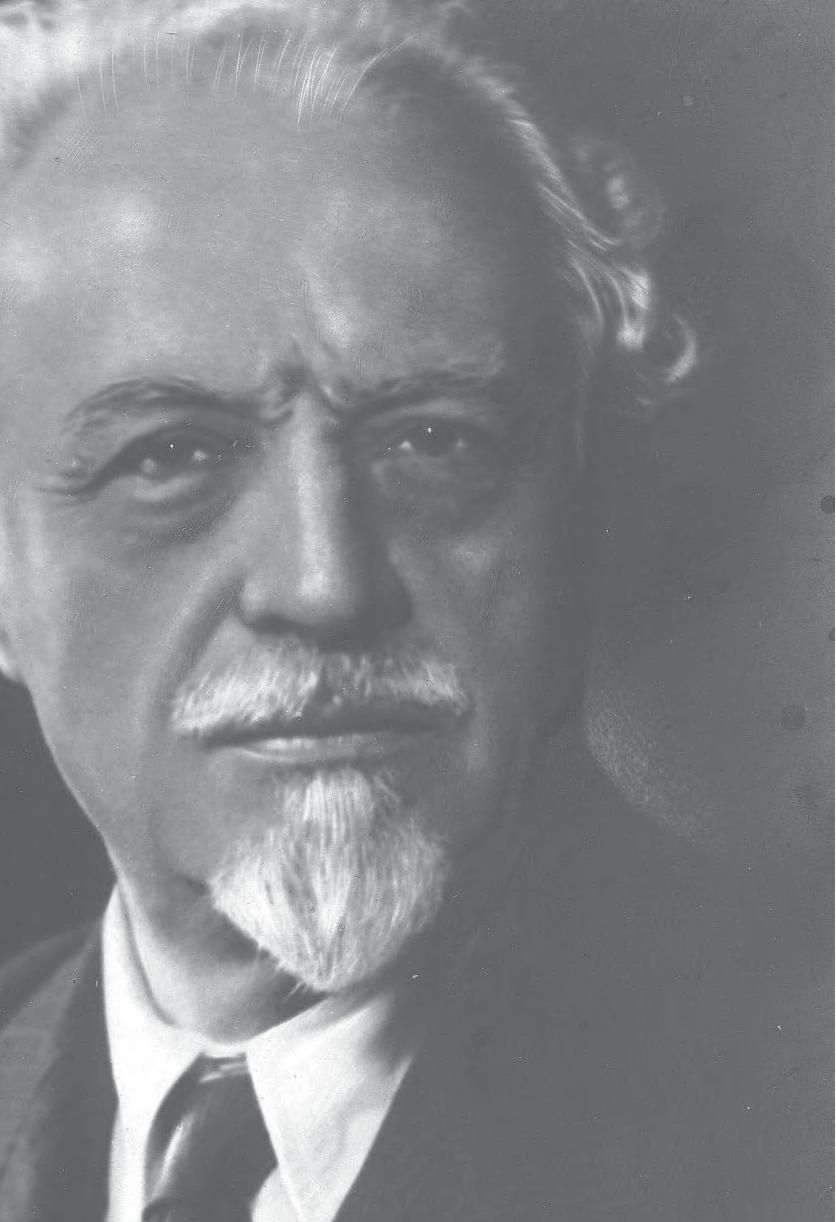 by Giuseppe Cacciaguerra
by Giuseppe Cacciaguerra
Political liberty is a vain shine unless accompanied by freedom from want and hunger and social liberty.

“Carneades! Who was he?” Don Abbondio’s famous question could,
What’s more, it would not be only a simple country curate who asked nerations of his fellow countrymen, much more educated than him. Nowadays, the name of Soleri is undeservedly hidden in the fog of oblivion. He was a great statesman in the true meaning of the word and ce, always at the country’s service. Moreover, he never came to terms with fascism; on the contrary, he was a proud opponent. The roots
desto Soleri, chief engineer, raised Marcello and his older brother Elvio according to the highest dictates of try, righteousness, total devotion to service to the institutions and great attention to social issues. On these parameters, the young Soleri set his “route angle” and never abandoned it. They tried to bribe him in every with money (a lot) and even with the fairer sex. Nothing diverted him from sary to do.
As a very young lawyer, his strong civic sense led him to compete in ge was the election as mayor in his ship in state institutions. Appointed deputy in Parliament, he became
mediately perceived his vigorous potential. In short, a brilliant young ton of liberalism. At the outbreak of party’s position of strict neutralism. When Italy, however, also took the needed to serve his homeland and, albeit a parliamentarian, left as a volunteer for the front. This was by thought. He did not hide and did
cused him of knowing nothing about the national spirit. For the record, Farinacci was an interventionist and one of the founders of the Combat Fasci. However, he was exempted from the war for almost its entire
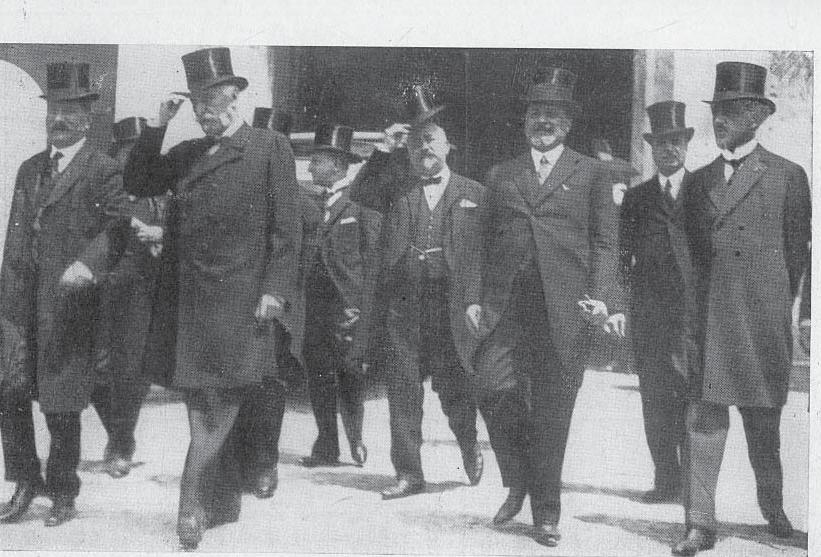
duration. On the other hand, Soleri

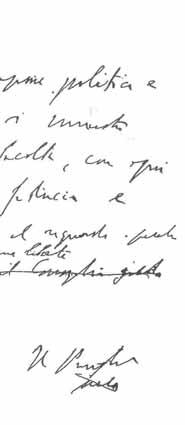
athers” until the end. He knew them ce that as Minister of War, on the gloomy clouds of fascism gathered over Rome, he asked that there be
ops who would serve to reinforce the state of siege, the declaration of which was believed imminent. At trols personally. He was not always granted this permission. His men loved and respected him; he did not mings he could handle alone. The lieved in him. He was brave against the enemy, but not only. Soleri, in his memoirs, recalls an episode that occurred to him shortly before being wounded in the assault on Monte Vodice (during the “tenth offensive”). Having reached hill 656, our artillery gallery regurgitant of spectators and ak to Gen. Badoglio. He asked him
art: “General, if you don’t believe it, vinced. The episode, however, has a curious and perhaps even bitter epilogue. The General, who went to punished” just because it came from him. Bear in mind that Soleri, on the Vodice, was seriously wounded. A machine gun bullet passed through his chest, puncturing his right lung. He was awarded the Silver Medal of Military Valour for that action and

He again asked for an assignment

he had a severe breakdown, which forced him to spend a long time in Cuneo, where he also fell ill with
a precise duty, but he also thought he was setting an example. He had to admit he was wrong: “I received thousands and thousands of exam those humble Alpini”.
a keen observer of that war. Exem plary was his speech on Caporetto delivered to the Chamber of Depu
nounce the lack of understanding of the soldier’s soul on the part of the commands: “in those days I lamen ted the example of careerism that came from high and the injustice in the distribution of risks. I regretted that evasion of military duties could not be eradicated, that the rest shi fts for the troops were not respected as they should, and that the special allowances were given to everyone except the soldiers in the trenches”. He was severe in his judgments: he could afford it because he was even more uncompromising with him self. It is no coincidence that in the
gned a burdensome – in many ways awkward – position: Undersecretary and then High Supply Commissio
do Collino Pansa, explains well why the choice fell on Soleri: “above all, he was known for his proverbial ada mantine honesty, which allowed him to defend the state from the adventu rers who circumvented it, in a sector where negotiations, purchases, and supplies took place for hundreds of millions”. He was forced to make un popular but necessary choices like certain bitter medicines. It was es sential to overcome the political pri
that farmers bought wheat to feed their livestock. On the subject, his expression was: “we must give bre ad the dignity to which it is entitled”. It was a long battle, but in the end, that
and guaranteed attention to those in res. He foresaw that the agricultural bread, the one in large loaves. For a short time, he was Minister of Finance in the government of Ivanoe Bonomi. Under the government of Luigi Facta, he was entrusted with signment with a worry engraved in the attitude of the Army towards the fascists and the order for peace to make”. His correspondence with the Army Corps Commanders indicates
wrote to the Commanders: “various sources report indications of an im minent insurgent movement, whi ch aims to seize the powers of the State by violent means. I am certain that no military element will want to join this movement by breaking es sential military oath duties [...] elimi nate any different conviction [...] take exemplary sanctions promptly”. In defence of Rome, he placed General Pugliese, to whom he gave the order to block any access to the capital by road and rail. In short, men and me ans did not lack. The measures taken and the intention to declare a state of columns of Blackshirts marching towards Rome give up. The state of siege decree was drawn up on the
“prevent the fascists, by all means, to occupy Rome and public authori ties (...)”. The ending is known: the King did not sign the declaration. In deed, he charged Mussolini to form the new government. Soleri’s place
always fought. He launched memo rable invectives against fascism un til the Duce got rid of the opposition thanks to the national list, also known as the “big list”. For Soleri, the years a dead pond, a squalid and empty period”. He lived utterly detached from public life “and journalism, whi ch also became totalitarian”. Wan ted and kept under observation in Piedmont, a region under the harsh where he also found refuge in the in Laterano. He lived under a false identity, with his new name: Santi cult time: he moved house seven or eight times in four months. Only with the fall of fascism did Soleri revive nister Bonomi wanted him to be the Treasury minister. For a change, the situation was desperate. His job was He restarted where he had precisely left off as Supply Commissioner, i.e. from the political price of bread. Al ready gravely ill, he made one last promote the national loan for recon struction. It was a real spiritual testa ment: “I tell you only one thing: we all must have a common vibration in our hearts: that is, we would all like to be nothing so that this Italy of ours will once again be everything”.
Our country lost a son, a wonderful example of dedication.
M. Soleri (edited by P.F. Quaglieni), Me morie, Libro Aperto Editore, Ravenna, 2013
R. Collino Pansa, Marcello Soleri, Gar
did not forget his father’s teachings
teotti’s disappearance, most parties secession of Aventine Hill. Thanks to Soleri, the liberal party did not partici pate. He managed to convince Giolit ti of the need to stay and make one’s voice heard. Not least, because “the absent are always wrong”. Soleri’s arena was the Parliament, where he
M. Brosio, Commemorazione di Marcel lo Soleri, con parole introduttive di Luigi Einaudi, Mario Fano ed Ivanoe Bonomi, M. Soleri (edited by P.F. Quaglieni), di Palazzo Lascaris n.48, Torino, 2013.
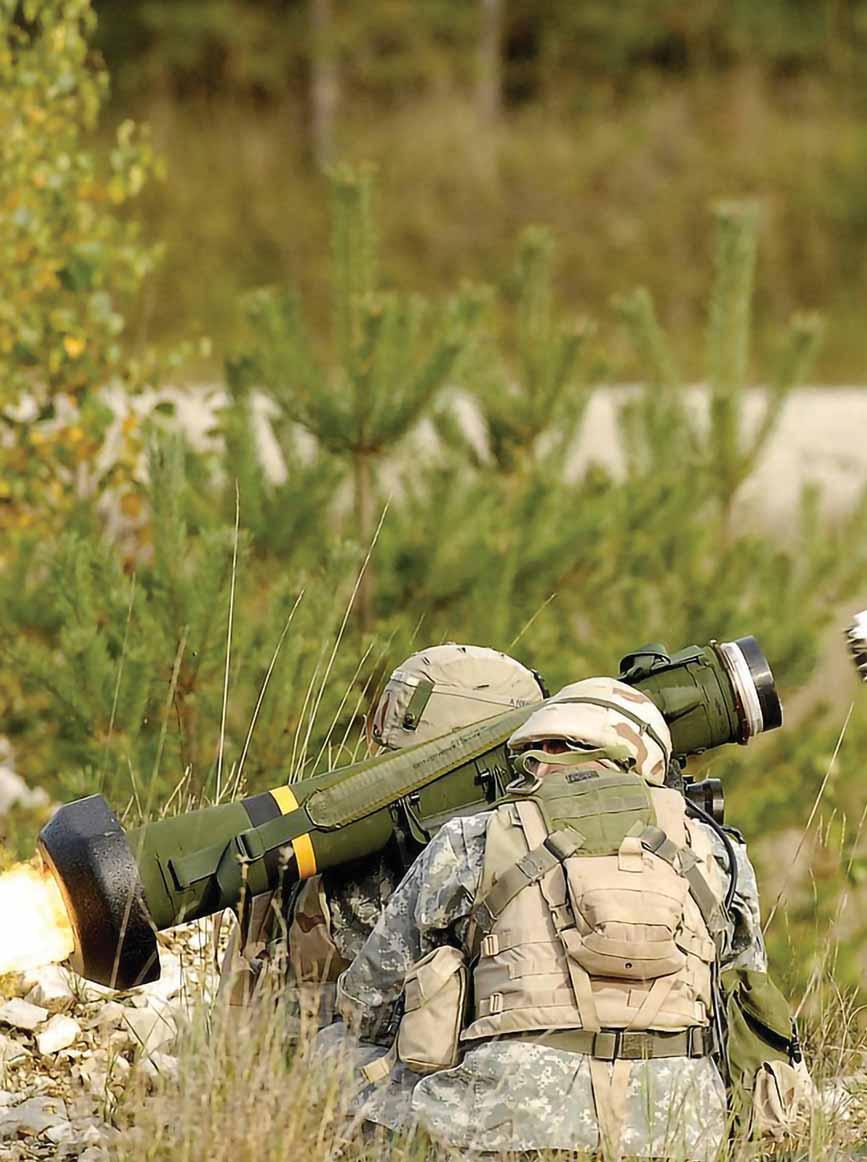 by Andrea Spada Andrea
by Andrea Spada Andrea


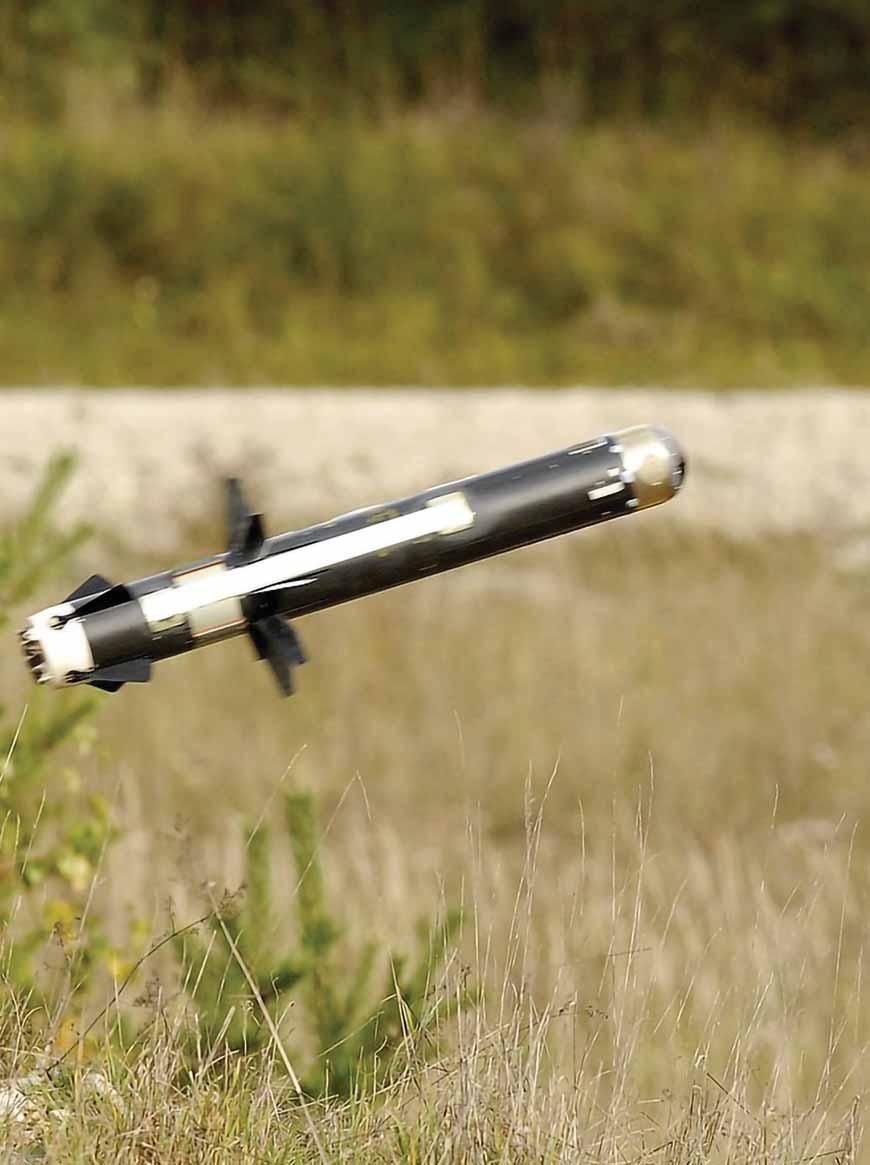
tide of war? Certainly not, but it can determine a series of reactions (rethinking the active protections for armoured vehicles or adopting new ones, different movement strategies which must be considered.

Among the various and numerous weapons supplied to Ukraine to le launchers stand out, becoming a real nightmare for the Moscow army. In particular, the American spite being 26 years old) designed against armoured vehicles, but also low altitudes.
symbols of Ukrainian resistance, capable of annihilating hundreds of tanks and armoured vehicles sent by the Kremlin. These missiles have become crucial and a symbol of the


cing Russian army. A meme created by a Canadian advertiser, Christian Borys, is also circulating on social networks, showing a saint of the Orthodox church, Mary Magdalene, holding the launcher.
pons in Ukrainian hands, but they are not the most numerous at their pment in the Ukrainian arsenal, the
the German Panzerfaust 3. Still, in lins have taken on a symbolic value far beyond the military one. The US companies Lockheed Martin and


entered service with the US military ver precision strikes against enemy
nade launchers. Lockheed Martin is now investing to increase the missile production rate beyond the current 2,100 per year (the target is 4,000
duction of the reusable, lightweight
velin missiles and more than 12,000 reusable command launch units. The missile system is expected to remain in the US arsenal until 2050 grades to maintain technological leadership against emerging threats and to support evolving operational needs.
chers with a system that was more effective, versatile, and easier to
Opposite page: “Javelin’”anti-tank missile.
The system consists of a reusable
dern tanks’ defences and reactive armour, even attacking them from above, where the armour is thinner. mously by the missile through the heat given off by the target itself, without the need for other human



ming is facilitated by the weapon’s sion and zoom.
velin is ejected from the launcher to reach a safe distance before the



 Selection of 2022 / Rivista Militare
Selection of 2022 / Rivista Militare
propulsion jet does not invest the room through a window due to the ring, about half a minute passes. A single missile costs about system, launcher and missile, cost the equipment with which one would like to run through the trenches.



ped with reactive armour.

ximum altitude of 60 meters higher than the release point; “Top Attack”, the missile soars up to 150 meters sary, in a dive. In fact, the upper part







the “Top Attack” mode, the missile falls on the target with a very high penetration power, thanks to the speed condition reached in a dive. The missile uses a double HEAT ce of modern reactive armour. The






licate part of a tank (the turret with the access door), favouring the destruction of the vehicle or, in any case, its deactivation and the crew’s neutralisation.
me a nightmare for Russian tankers.
bre), while the launcher weighs 6.4 kg for a length of 120 cm. However, it is much more manageable than



















cond (main) charge penetrates the armour. While HEAT warheads are ve laterally against modern tanks due to reactive armour designed



se to a quintal. The muzzle speed is 50 km/h in departure and 250 km/h

overcoming homogeneous armour



velin launcher, they are considered absolutely lethal to these vehicles. In fact, the missile does not hit the tank from the side, where the heavy
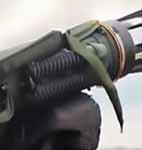
scow use to limit the damage to its armoured vehicles? Modern Russian tanks have developed and tested the ARENA active protection system countermeasure system developed by the Russian engineering design bureau Kolemenskoye to protect guided missiles and those designed with attack capability from above. After the disastrous losses suffered by Russian armoured forces during
skoye devised the ARENA system of active countermeasures in the early
termine incoming warheads. It then tonate immediately above the target






